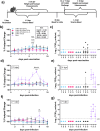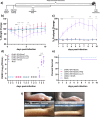Enhanced attenuation of chikungunya vaccines expressing antiviral cytokines
- PMID: 38472211
- PMCID: PMC10933427
- DOI: 10.1038/s41541-024-00843-x
Enhanced attenuation of chikungunya vaccines expressing antiviral cytokines
Erratum in
-
Author Correction: Enhanced attenuation of chikungunya vaccines expressing antiviral cytokines.NPJ Vaccines. 2024 Apr 16;9(1):79. doi: 10.1038/s41541-024-00868-2. NPJ Vaccines. 2024. PMID: 38627437 Free PMC article. No abstract available.
Abstract
Alphaviruses are vector-borne, medically relevant, positive-stranded RNA viruses that cause disease in animals and humans worldwide. Of this group, chikungunya virus (CHIKV) is the most significant human pathogen, responsible for generating millions of infections leading to severe febrile illness and debilitating chronic joint pain. Currently, there are limited treatments to protect against alphavirus disease; thus, there is a tremendous need to generate safe and effective vaccines. Live-attenuated vaccines (LAVs) are cost-effective and potent immunization strategies capable of generating long-term protection in a single dose. However, LAVs often produce systemic viral replication, which can lead to unwanted post-vaccination side effects and pose a risk of reversion to a pathogenic phenotype and transmission to mosquitoes. Here, we utilized a chimeric infectious clone of CHIKV engineered with the domain C of the E2 gene of Semliki Forest virus (SFV) to express IFNγ and IL-21-two potent antiviral and immunomodulatory cytokines-in order to improve the LAV's attenuation while maintaining immunogenicity. The IFNγ- and IL-21-expressing vaccine candidates were stable during passage and significantly attenuated post-vaccination, as mice experienced reduced footpad swelling with minimal systemic replication and dissemination capacity compared to the parental vaccine. Additionally, these candidates provided complete protection to mice challenged with WT CHIKV. Our dual attenuation strategy represents an innovative way to generate safe and effective alphavirus vaccines that could be applied to other viruses.
© 2024. The Author(s).
Conflict of interest statement
The authors declare no competing interests.
Figures






References
-
- Organization, W. H. Chikungunya Fact Sheet, (2021).
-
- PAHO. (World Health Organization, Pan American Health Organization, 2015).
-
- Chikungunya Cases by Country or Territory. (2023).
Grants and funding
LinkOut - more resources
Full Text Sources

